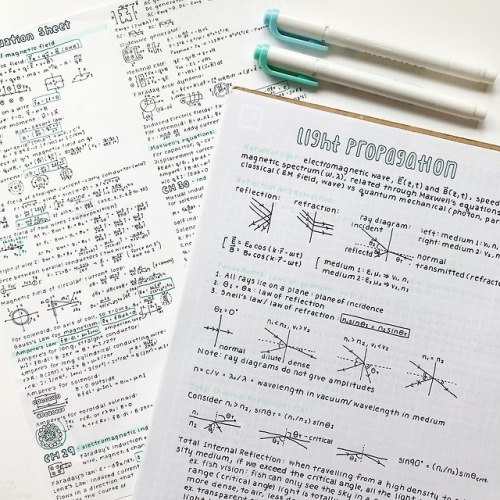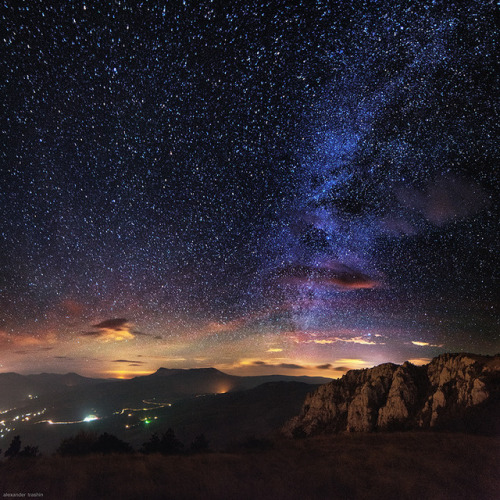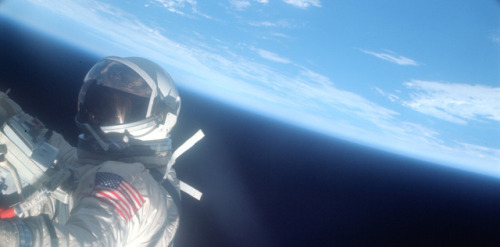“As The Centuries Unfold, Millions Of Artists Will Live On The Moon And Paint The Moon And Mars As

“As the centuries unfold, millions of artists will live on the moon and paint the moon and Mars as we go out into the universe.”
Today we remember the fourth man to walk on the moon. Astronaut Alan Bean passed away in Houston, at the age of 86.
Bean was the lunar module pilot for Apollo 12 in November 1969, and was commander of Skylab 3 in June 1973. He retired from NASA in 1981 to devote his time to painting.
More Posts from Maxx85 and Others








Lockheed Martin engineers assemble Orion’s crew module at NASA Kennedy Space Center Operations and Checkout building. Orion will travel 450,000 km away from Earth on Exploration Mission-1.
How to Care Less about What Other People Think
1. Know what matters to you, personally – what you stand for, and what your values are .
2. Don’t be anxious about breaking social norms. The more often you do this, the less it bothers you.
3. Decide not to live as a people pleaser, or to get upset and take rejection personally.
4. Hang out with people who are self confident, who know what they believe in, and what they want from life. You’ll find that their self-confidence will rub off on you, too.
5. Try to work on becoming more competent in the skills and areas that matter to you. That will naturally enhance your self confidence, and develop a self image that is strong and positive.
6. Travel, and spend time with different kinds of people. That will show you how diverse attitudes and outlooks are. There’s no one way of being – so find, and be, yourself.

Notetaking
Sound Note - take notes while you record audio
Evernote - notetaking that syncs across platforms
Paper 53 - minimal notetaking that syncs
Microsoft OneNote - collaboration and syncing, best for Office users
Google Keep - jot things down, best for Google suite users
Notability - take notes and annotate PDFs
Mindly - create mind maps
Day One - a digital journal
Flash Cards
Quizlet - the quintessential flash card app
StudyBlue - another commonly used app
Cram - best for its “cram mode”
Eidetic - uses spaced repetition for effective memorization
Planner
My Study Life - schedules, tasks, reminders, and more
StudyCal - keeps track of tasks, exams, and grades
24me - automated reminders and event planning
iStudiez - schedule and prioritized task list
Google Calendar - a calendar, best for Google users
Glass Planner - a calendar and to do list with incredible functionality
To Do List
Clear - organized to-do and reminders
MinimaList - simple to-do and focus timer
Trello - collaborative project organizer
Todoist - clean and functional task manager
Default notes app on your phone
Time Management
Forest - plant trees by staying focused
Pomotodo - pomodoro timer with to-do list
Timeglass - custom timers
Tide - pomodoro with white noise
Alarmy - forces you out of bed
Pillow - smart alarm that tracks sleep cycles
Productivity
Workflow - automate tasks
Habitica - turn your habits into an RPG
Continuo - simple, colorful activity tracking
Freedom - block distracting apps
Free Learning
Coursera - free MOOCs
TED - listen to Ted Talks
Duolingo - language learning
Memrise - spaced repetition language vocabulary
Khan Academy - free video lessons
Ambient Noise
8tracks - curated playlists
Spotify - online music streaming
Coffitivity - cafe ambience
Noisli - background sound generator
Rain Rain - rain sounds
Binaural - binaural beats
Health
Rockin Ramen - recipes based on ramen
MealBoard - meal planning
Lifesum - healthy eating
Stop Breath And Think - mindfulness meditation
Pacifica - mental health management
Sworkit - personalized video workouts
Waterlogged - hydration tracker
Reference
WolframAlpha - Google on steroids
Oxford Dictionary - all of English at your fingertips
RefMe - citation generator
PhotoMath - solve math problems by taking a photo
Mathway - step by step math help
Desmos - free graphing calculator
Wikipedia - not the best source, but it’s handy
Miscellaneous
Companion - stay safe when walking alone
Mint - money management
Toshl - finance manager
Tiny Scanner - scan documents
I know some of y'all aren’t ok but still gotta study for their stuff so
Its ok, just take it easy my friend.Take a min when you need one. Don’t forget to rest. No pushing yourself too hard, you are already proving that you are trying your best by still studying. 😊
And take care of yourself, boo.💟
How to Stop Comparing Yourself to Others
1. Don’t listen to the voice inside your head that tells you that you are inadequate.
2. Don’t hang out with people who look for the flaws and can’t see the best in the people in their lives.
3. Recognise that each person is different and unique. There is no-one like you - and you have great attributes.
4. Take note of your efforts, and the progress you have made. You’ve already come far. You should celebrate that!
5. Appreciate others, and what you gain from them. Don’t see them as people who undermine you.
6. Remember that NO-ONE is perfect at all - and that other people struggle with the same stuff as well.
7. Go after what matters the most in this life: being loyal, and thoughtful, and caring, and kind.
Meet More Humans Behind the Robots
There are many paths to a career at NASA. Here are 10 amazing people on the frontlines of deep space exploration.
1—The Pub Master

“I was running a pub in the North of England after dropping out of college, and as fate would have it, I met a lovely American physics lecturer Dr. Jim Gotaas,” said Abi Rymer (shown above in the bottom right of the group photo). Abi works on the Europa Clipper mission.
“I was sold on a course he ran on Observational Astronomy and Instrumentation at the University of Central Lancashire in Preston, Lancashire and I went from there to join the second year of the Physics and Astronomy at Royal Holloway, part of London University. I loved theoretical physics but never imagined I was talented enough to do a PhD. When I graduated, I was shocked to be top of the year.”
2—The Orbit Artist

“Within seven months of being at NASA’s Jet Propulsion Laboratory,” says Brent Buffington, a mission design manager, “I figured out we could modify the Cassini Prime Mission trajectory to fly very close to the moon Tethys—a moon that didn’t have any close flybys in the original Prime Mission—and simultaneously lower a planned 621-mile (1,000-kilometer) targeted flyby of Hyperion down to 311 miles (500 kilometers). To be this young buck fresh out of grad school standing in front of a room full of seasoned engineers and scientists, trying to convince them that this was the right thing to do with a multi-billion dollar asset, and ultimately getting the trajectory modification approved was extremely rewarding.”
3—The Searcher

“Geochemical evidence suggests that between 4 and 2.5 billion years ago, there may have been an intermittent haze in the atmosphere of Earth similar to the haze in the atmosphere of Saturn’s moon Titan,” says astrobiologist Giada Arney. “It’s a really alien phase of Earth’s history —our planet wouldn’t have been a pale blue dot, it would have been a pale orange dot. We thought about questions like: What would our planet look like if you were looking at it as an exoplanet? How you might infer biosignatures—the signs of life—from looking at such an alien planet?”
4—The Volcanologist

“I spent the summer after graduating from studying Mars’ remnant magnetic field in the Planetary Magnetospheres Lab at NASA Goddard Space Flight Center,” says planetary geophysicist Lynnae Quick. “My advisor, Mario Acuña, showed me how to bring up Mars Global Surveyor (MGS) images of the Martian surface on my computer. This was the first time I’d ever laid eyes, firsthand, on images of another planet’s surface returned from a spacecraft. I remember just being in awe.
“My second favorite moment has to be pouring over mosaics of Europa and learning to identify and map chaos regions, impact craters and other surface units during my first summer at APL. Once again, I felt that there was a whole other alien world at my fingertips.”
5—The Pioneer

“A few months after NASA was formed I was asked if I knew anyone who would like to set up a program in space astronomy,” says Nancy Roman, a retired NASA astronomer. “I knew that taking on this responsibility would mean that I could no longer do research, but the challenge of formulating a program from scratch that I believed would influence astronomy for decades to come was too great to resist.”
6—The Modeler

“I took Planetary Surfaces with Bruce Murray (whom I later found out had been JPL’s fifth director) and did a presentation on Europa’s chaos terrains,” say Serina Diniega, an investigation scientist on the Europa Clipper mission. “I was fascinated to learn about the different models proposed for the formation of these enigmatic features and the way in which scientists tried to discriminate between the models while having very limited observational data. In this, I realized I’d found my application: modeling the evolution of planetary landforms.“
7—The Bassist

“I admire people who dedicate themselves 110 percent to what they do,” says Warren Kaye, a software engineer. “People like the recently deceased Stephen Hawking, who rose above his own physical limitations to develop new scientific theories, or Frank Zappa, who was able to produce something like 50 albums worth of music over a 20-year span.”
8—The (Space) Photographer

“I got to pick what the camera took pictures of in a given week, and then analyze those pictures from the standpoint of a geologist,” says Tanya Harrison, a planetary scientist. “There aren’t many people in the world who get paid to take pictures of Mars every day! Seeing the first images…It was almost surreal – not only are you picking what to take pictures of on Mars, you’re also typically the first person on Earth to see those pictures when they come back from Mars.”
9—The Scientist

As a child, what did you want to be when you grew up?
“A scientist,” says Casey Lisse, a scientist on our New Horizons mission to Pluto and the Kuiper Belt.
At what point did you determine that you would become a scientist?
“Age 5.”
10 —The Extrovert

“Throughout my life, I’ve gone from being an extremely shy introvert to more of an outgoing extrovert,” says science writer Elizabeth Landau. “It’s been a gradual uphill climb. I used to be super shy. When I was really young, I felt like I didn’t know how to talk to other kids. I was amazed by how people fluidly spoke to each other without thinking too hard about it, without appearing to have any kind of embarrassment or reservation about what they were saying. I’ve definitely developed confidence over time—now I can very quickly and comfortably switch from talking about something like physics to personal matters, and be totally open to listening to others as well.”
Check out the full version of “Solar System: 10 Things to Know This Week” HERE.
Make sure to follow us on Tumblr for your regular dose of space: http://nasa.tumblr.com.

Had a physics midterm today, so here are some physics notes :-) Have a great day!
instagram: https://www.instagram.com/lentilstudies/

South Demerdji, Crimea by Alexander Trashin
js










Happy Birthday to moonwalker Buzz Aldrin, born as Edwin Eugene Aldrin, Jr. in Glen Ridge, New Jersey, on January 20, 1930.




“To always be aware that, suddenly and unexpectedly, we may find ourselves in a role where our performance has ultimate consequences.”
Remembering the brave crews of Apollo 1, Challenger, and Columbia today at Johnson Space Center.
-
 beyondafinecupofcoffee liked this · 5 months ago
beyondafinecupofcoffee liked this · 5 months ago -
 prndandroid liked this · 1 year ago
prndandroid liked this · 1 year ago -
 alixiria reblogged this · 1 year ago
alixiria reblogged this · 1 year ago -
 techieninjagirl reblogged this · 2 years ago
techieninjagirl reblogged this · 2 years ago -
 techieninjagirl liked this · 2 years ago
techieninjagirl liked this · 2 years ago -
 faeriequeen67 reblogged this · 2 years ago
faeriequeen67 reblogged this · 2 years ago -
 faeriequeen67 liked this · 2 years ago
faeriequeen67 liked this · 2 years ago -
 strugglingqueer liked this · 2 years ago
strugglingqueer liked this · 2 years ago -
 spacenerdsarah liked this · 3 years ago
spacenerdsarah liked this · 3 years ago -
 fiindiing-neverland liked this · 3 years ago
fiindiing-neverland liked this · 3 years ago -
 edwhiteandblue liked this · 4 years ago
edwhiteandblue liked this · 4 years ago -
 jennrg reblogged this · 4 years ago
jennrg reblogged this · 4 years ago -
 hamburger--time liked this · 4 years ago
hamburger--time liked this · 4 years ago -
 apollo-cookies liked this · 4 years ago
apollo-cookies liked this · 4 years ago -
 felixkeepswalking liked this · 4 years ago
felixkeepswalking liked this · 4 years ago -
 someothershadeofpink liked this · 4 years ago
someothershadeofpink liked this · 4 years ago -
 junohnebula liked this · 5 years ago
junohnebula liked this · 5 years ago -
 reindeermars liked this · 5 years ago
reindeermars liked this · 5 years ago -
 ardeadentro liked this · 5 years ago
ardeadentro liked this · 5 years ago -
 ohai-mg liked this · 5 years ago
ohai-mg liked this · 5 years ago -
 cold-beer-conversation liked this · 5 years ago
cold-beer-conversation liked this · 5 years ago -
 transarkadydzyubin liked this · 5 years ago
transarkadydzyubin liked this · 5 years ago -
 facslvr liked this · 5 years ago
facslvr liked this · 5 years ago -
 spaceraceoutfitters reblogged this · 5 years ago
spaceraceoutfitters reblogged this · 5 years ago -
 mr2cool4school liked this · 5 years ago
mr2cool4school liked this · 5 years ago -
 woodyredwoody liked this · 5 years ago
woodyredwoody liked this · 5 years ago -
 -wellisntthatwizard reblogged this · 5 years ago
-wellisntthatwizard reblogged this · 5 years ago -
 genna-ivanovich liked this · 5 years ago
genna-ivanovich liked this · 5 years ago -
 tagitables reblogged this · 5 years ago
tagitables reblogged this · 5 years ago -
 127-lz liked this · 5 years ago
127-lz liked this · 5 years ago -
 just-another-product-of-today reblogged this · 5 years ago
just-another-product-of-today reblogged this · 5 years ago -
 just-another-product-of-today liked this · 5 years ago
just-another-product-of-today liked this · 5 years ago -
 emmythespacecowgirl reblogged this · 5 years ago
emmythespacecowgirl reblogged this · 5 years ago -
 iambasilgnome liked this · 5 years ago
iambasilgnome liked this · 5 years ago -
 good-and-colorful liked this · 5 years ago
good-and-colorful liked this · 5 years ago -
 britanniadoyle liked this · 5 years ago
britanniadoyle liked this · 5 years ago -
 un-ionizetheradlab reblogged this · 5 years ago
un-ionizetheradlab reblogged this · 5 years ago -
 idreamilyatomiccollector liked this · 5 years ago
idreamilyatomiccollector liked this · 5 years ago -
 enviropop liked this · 5 years ago
enviropop liked this · 5 years ago -
 per-aspera-ad-astra-m reblogged this · 5 years ago
per-aspera-ad-astra-m reblogged this · 5 years ago -
 per-aspera-ad-astra-m liked this · 5 years ago
per-aspera-ad-astra-m liked this · 5 years ago